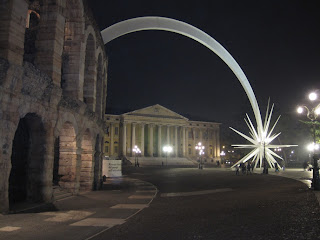Benvenuto! I have created this blog to share my international experiences with you. I will be spending the next 5 months in Bologna, Italy, with hopefully many excursions to the surrounding areas in Italy and greater Europe. I just bought a shiny new camera, so expect lots of photos!
Here is a quick overview of my study abroad program. The University of Bologna, founded in 1088 A.D., is the oldest university in the Western world. There are about 100,000 students in the university and 23 faculties or departments. Notable alumni include:
-Dante Alighieri (wrote the Divine Commedy)
-Francesco Petrarca (aka Petrarch, a poet)
-Paracelsus (alchemist)
-Leon Battista Alberti (wrote the book on perspective painting)
-Albrecht Dürer (German artist)
-Nicolaus Copernicus (realized the Earth was round)
-Luigi Galvani (discovered that the muscles of dead frogs twitched when electrocuted)
-Camillo Golgi (as in "Golgi body")
-Pier Paolo Pasolini (20th century Renaissance man)
-Romano Prodi (Italian prime minister)
I will be studying at this prestigious and historic university, which gave the city of Bologna the nickname
la dotta, or,
the learned. Bologna has two other nicknames as well: next is
la grassa, or,
the fat one, for it's fine gastronomical heritage. Bologna is considered the culinary capital of a seriously food-centric country. I've heard that there are something like 450 restaurants in the tiny, medieval city, and that even the smallest holes in the wall have amazing food. The third nickname is
la rossa, or,
the red, which stems from Bologna being known as one of the more historically socialist parts of Italy. Today, Bologna is the most liberally minded of Italian cities, and a center of art, history, music, cuisine, and people who like to talk about politics.
Here is an aerial view of the city. In the center are Piazza Maggiore and the Basilica of San Petronio.

In the bird's eye picture below, you can discern the hexagon-like outline of the walls that used to surround the city.

Bologna is a very old city with a fascinating history, like most of Italy. It was founded by the Etruscans, conquered by the Celts, conquered by the Romans, conquered by the Lombards, conquered by Modena, conquered by Milan, and even conquered by the Pope. Finally, the Pope gave Bologna to the Royal Crown of Savoy and then it became part of a unified Kingdom of Italy. The thing to remember about Italian history is that it is really an amalgamation of a whole slew of unique histories. Between the fall of Rome and unification in the 1860s, Italy was composed of many diverse city states, all with their own unique governments, customs, languages, and, of course, food.
So this brings me to my two main goals for the semester: (1) to hone my Italian language skills, and (2) to experience first-hand some of the unique regional differences of Italy.








































